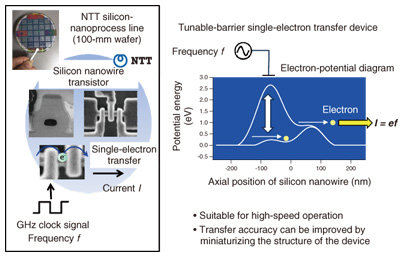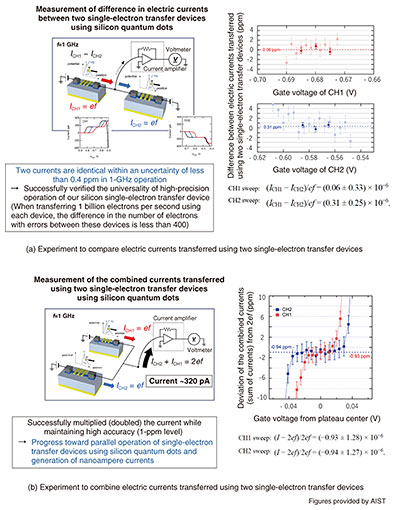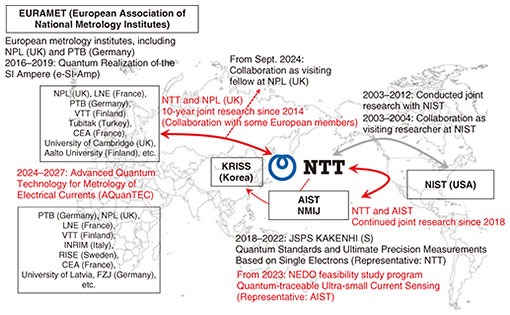 |
|||||||
|
|
|||||||
|
Front-line Researchers Vol. 23, No. 2, pp. 1–7, Feb. 2025. https://doi.org/10.53829/ntr202502fr1  Pursuing Electric Current Standard Using Single-electron Transfer Devices through International CollaborationAbstractIn 2019, the definition of the ampere, the unit of electric current in the International System of Units (SI), was changed from the ampere with which it was physically impossible to implement the defined quantity of the unit of measure to the ampere that can be implemented using quantum devices. Researchers worldwide are now researching to establish a quantum current standard on the basis of the new definition of the ampere. We spoke with Akira Fujiwara, a senior distinguished researcher at NTT Basic Research Laboratories, who developed silicon single-electron transfer devices, one of the basic elements for implementing the electric current standard, and is working toward establishing the electric current standard using such devices through international collaboration. He explained his approach to establishing the electric current standard using silicon single-electron transfer devices, the community that is carrying out this approach, and his thoughts on conducting research in the global arena through friendly competition and discussion. Keywords: single-electron device, electric current standard, quantum metrology triangle High-speed and high-accuracy operation of single-electron transfer devices enables the achievement of a quantum metrology triangle and provides the basis for establishing a quantum current standard—Could you tell us about the research you are currently conducting? The movement of electrons creates an electric current, and I am researching technology to precisely control individual electrons that make up that electric current. The definition of the ampere, the unit of electric current in the International System of Units (SI), was revised in 2019. That is, the ampere was previously defined either as (i) the direct current flowing through each of the two straight conductors of infinite length and with infinitely small circular cross-sections placed in parallel one meter apart in a vacuum and producing between these conductors a magnetic force equal to 2 × 10−7 newtons per meter of length or (ii) the alternating current whose square root of the mean over one cycle of the square of the instantaneous value represented by the ampere defined as in (i) is one, which is experimentally impossible to implement. The ampere is now defined as the current determined by setting the elementary charge (electric charge carried by an electron) to be 1.602176634 × 1019 coulombs. This new definition makes it possible to express the ampere by directly multiplying the frequency and elementary charge by using semiconductor devices. I discussed in my previous interview (February 2022 issue) how we are competing with researchers worldwide to establish electric current standards on the basis of the new definition of the ampere. One approach to establish the electric current standard is to generate a precise magnitude of an electric current by using a single-electron transfer device. When a clock signal with frequency f is applied to a single-electron transfer device, which transfers one electron per clock cycle, the current value matches the product of the frequency and amount of elementary charge carried by one electron. To use this approach for a practical electric current standard, it is necessary to improve the speed and accuracy of a single-electron transfer device. Using silicon nanofabrication technology, we at NTT have fabricated silicon quantum dots that store and release electrons one at a time and achieved an operating condition in which the quantum dot almost always contains exactly one electron. Incorporating this silicon quantum dot, our single-electron transfer device can generate a precise magnitude of electric current, achieving high-speed and high-accuracy operation (Fig. 1).
Another approach is to use the quantum metrology triangle (QMT), which is an experiment to verify the consistency of quantum electrical standards based on Ohm’s law. Ohm’s law is expressed as voltage V = current I × resistance R. The QMT expresses this law in the world of quantum mechanics, and an electric current generated from a single-electron transfer device is compared with that generated from a combination of the Josephson voltage standard and quantum Hall resistance standard. The Josephson voltage standard uses superconductors at a frequency f to generate voltages. The output voltage and quantum Hall resistance standard are used to derive an electric current standard. However, a method for deriving an electric current standard from a frequency has not been established, and we are working on deriving an electric current standard by using NTT’s single-electron transfer devices. —What are the challenges with single-electron transfer devices to be applied to electric current standards? With silicon single-electron transfer devices, due to errors that occur during transfer and the effects of crystal defects, electrons do not enter and exit each quantum dot exactly one at a time, and errors (namely, no electrons or two electrons are transferred instead) can occur, albeit at extremely low probability. For single-electron transfer devices to be applied to electric current standards, it is necessary to operate universally with high precision across multiple independent devices (universality). Since the accuracy of measuring the probability of an error decreases as the current becomes extremely small, a larger current is necessary to improve measurement accuracy. Therefore, it is necessary to collect the extremely small currents generated by the devices and obtain a larger current (namely, generating a nanoampere current by operating multiple single-electron transfer devices in parallel). To verify compliance with these requirements, it is necessary to precisely measure multiple devices in parallel so that they fall within the range of requirements. We carried out this measurement in collaboration with the National Institute of Advanced Industrial Science and Technology (AIST), which has precision current-measurement technology for accurately measuring minute currents [1, 2]. We designed and developed a sample holder that makes it possible to individually measure a large number of single-electron transfer devices at dilution-refrigerator temperatures for operating multiple devices in parallel (to compare and combine electric currents). With this holder, we measured—with the world’s highest precision—electric currents generated from two of NTT’s GHz-operating silicon single-electron transfer devices that showed good characteristics by using a dilution refrigerator developed by AIST for QMT experiments. We conducted two experiments for the above measurements: comparing electric currents generated using two independent single-electron transfer devices and combining two electric currents generated using two independent single-electron transfer devices. From the first experiment, we confirmed that the two electric currents are identical within an uncertainty of less than 0.4 ppm at 1-GHz operation. In other words, if one billion electrons are transferred per second using each device, the difference in the number of electrons with errors between these devices is less than 400, which verifies the universality of our silicon single-electron transfer devices (Fig. 2(a)). We are currently working toward achieving our final target of 0.01 ppm (10–8). In the second experiment, we succeeded in doubling the current while maintaining high precision at the 1-ppm level (Fig. 2(b)). These results, namely, confirming the universality of our single-electron transfer devices to be used for a quantum current standard and clearing a technical hurdle for the verification of the QMT, signify a major step toward the completion of a quantum electrical standard system.
The above results will lead to the calibration of electrical and electronic measuring instruments and development of portable quantum electrical standards, thus will contribute to the industrial infrastructure and metrology fields and be applied in a wide range of fields related to electrical quantities materials, such as precision resistance evaluation, single-molecule and chemical-reaction sensors, and radiation sensors, in the chemical, industrial, and medical fields. We also expect them to be applied to ultimate precision measurements such as ultra-small current measurement. We have demonstrated precise parallel operation of silicon quantum dots, which we expect to lead to quantum-dot integration technology. This research was supported by a Grant-in-Aid for Scientific Research (KAKENHI) (S) from the Japan Society for the Promotion of Science (JSPS) called “Quantum Standards and Ultimate Precision Measurements Based on Single Electrons” (JP18H05258). —I heard that as well as the joint research with AIST that you just described, you are also involved in various other collaborations to establish an electric current standard. Since standardization of a technology cannot be done if research on the technology is conducted solely on its own, it is important to build a group of people who cooperate in standardization, for example, NTT creates a device and other parties measure with high precision to evaluate it (Fig. 3).
From 2003 to 2012, we collaborated with the National Institute of Standards and Technology (NIST) in the USA. During that time, from 2003 to 2004, I was a visiting researcher at NIST. From 2014 to 2024, we collaborated with the National Physical Laboratory (NPL) in the UK on demonstrating, for example, high-speed, high-precision operation of silicon single-electron transfer devices. In September 2024, I was appointed a visiting fellow at NPL. From 2016 to 2019, during my joint research with NPL, I also collaborated with European metrology institutes on the Quantum Realization of the SI Ampere project (e-SI-Amp), and during that collaboration we demonstrated the high accuracy of NTT’s devices. In 2020, we confirmed 1-GHz, sub-ppm operation of a silicon single-electron transfer device by using three different measuring instruments, including those at NPL and the Technical Research Centre of Finland (VTT), and demonstrated the application of the device to a transportable standard. This collaboration continues to this day, and we plan to use NTT’s devices to cooperate on the new Advanced Quantum Technologies and Current Measurements (AQuanTEC) project, which was launched by European metrology institutes and will run from 2024 to 2027. We are also engaged in such collaborative co-creation activities in Japan. As well as collaborating on the aforementioned “Quantum Standards and Ultimate Precision Measurements Based on Single Electrons” funded by JSPS Grant-in-Aid for Scientific Research, we have been participating in a feasibility study program of the New Energy and Industrial Technology Development Organization (NEDO) titled “Quantum-traceable Ultra-small Current Sensing” since 2023. NTT is responsible for the development of an ultra-small quantum-current source at the pico- to femto-ampere level, while Japan Finechem (now Mitsubishi Gas Chemical Next) is responsible for the development of a precision ultra-high-value resistor (1 TΩ). The entire project team, centered around AIST and including Tokyo Institute of Technology (transferred to the University of Tokyo in 2024), is developing an ultra-high-performance ultra-small-current measurement system for measuring fine particles and radiation, chemical reactions, and biological measurements. For single-electron control, in addition to collaborating on the initiatives that I mentioned above, we are researching—on both the theoretical and experimental levels—the theme of understanding and controlling the quantum dynamics of single electrons in silicon quantum dots. This is with the aim of precisely controlling single electrons under the high-speed operation required to achieve the QMT. We are also promoting collaboration in different fields, and using the knowledge we have gained, we are teaming up with the University of Tokyo and Centre National de la Recherche Scientifique (CNRS), France on the theme of a single-electron shuttle using molecular devices [3]. A molecule attached to the tip of DNA stores a single electron and moves in Brownian motion between upper and lower electrodes in a manner that generates an electric current through single-electron-shuttle transport, and that current is used for electrical measurements of molecular dynamics. In this research, NTT is providing theoretical support for (i) current and noise analysis based on single-electron counting theory and (ii) molecular and particle dynamics using Fokker-Planck simulations (numerical calculations based on physical models). The electric current generated through the single-electron shuttle using molecular devices can be used in bio- and electrochemical sensors and has the potential to be used for a new electric current standard. Producing results by contributing to a community where various people naturally come together for friendly competition and discussion while being aware of application of research findings—What do you keep in mind as a researcher? I keep in mind four key points concerning my research, namely, community building, friendly competition and discussion, application of research findings, and work-life balance. Regarding community building, I think that instead of adopting a research style by which we aim to be self-reliant and appeal to the world by writing and publishing papers alone, we should form a research community in which various people can participate and contribute to the community then revitalize and expand the community in a way that leads to a flow of abundant creative results. An electric current standard, my research theme, cannot be established without international cooperation. Although this field—single-electron devices—is very important as a component of the quantum electrical standard system, it is not necessarily a major field from the viewpoint of industrial applications. If individual researchers act in isolation, not only may these devices not be adopted to standards but may even disappear. That is why community building is important. I will endeavor to contribute as a member of the community and strive to help revitalize and expand it in cooperation with all the participants. Friendly competition and discussion also relates to community building. Since we are researchers in the same field, there is competition over who will be the first to publish a paper, and this competition leads to self-improvement. However, I think it is important to avoid self-satisfaction by having sincere discussions as members of the community and to make progress as a whole while striving to create something new. I am currently in an environment—both inside and outside the company—where I can discuss things regardless of age or position in a manner that I find stimulating. The community provides a forum and environment for discussion that transcends country, affiliation, and other restrictions. It is thus necessary to go beyond NTT and reach out to the world, where we can continue to improve ourselves and debate our ideas. Application of research findings concerns considering the field in which basic research results will be applied. I think that unless you are conducting purely basic research, it is necessary to be continuously aware of application of research findings and think about a scenario that is consistent with the academic significance of the basic research you are investigating. Sometimes you may realize that the vectors of basic and applied research are not aligned. However, this realization can clarify your position as a researcher and allow you to correct your course. Regarding work-life balance, as you continue your research, you will inevitably go through phases where you push yourself to get results. If this situation continues for too long, it can be mentally and physically tough and prevent flexible thinking. By being conscious of your work-life balance on a daily basis and continuing to pursue a hobby or interest, even if it is just a small thing, you can have a “place to return to” when you feel overwhelmed, enabling you to go there and recharge, leading to good results. I enjoy playing the piano and dancing, e.g., salsa and classical ballet. After the COVID-19 pandemic had subsided, I attended an international conference held in Northern Europe and gave an invited lecture. After the lecture, I had the opportunity to visit the laboratory of a Finnish professor who is a world authority in the single-electron device community and had a good discussion with him. I asked him if I could hold a seminar during my visit, and he readily agreed. In fact, when we met again after a long time, he greeted me with a hug! The professor is not only a researcher I admire but also someone who understands the results of my research, so I felt very happy to be reunited with him. Research is, after all, an activity carried out by people, and connections between people are very important as a motivation for research. I have renewed my desire to continue contributing as a true professional researcher by leaving behind at least one new achievement and livening up the community. Understanding your strengths and weaknesses and challenging yourself in the global arena—What is your message to junior researchers? The term “globalization” has long since become commonplace, and NTT has also been expanding its various businesses globally. NTT laboratories have been active in the global arena from early on, as in joint research with overseas laboratories and international standardization activities, and have taken a leading role in building international communities such as the IOWN Global Forum. Since we are working in such a wonderful environment, I hope that you will not rest on your laurels in Japan or at NTT; instead, I hope you will go out into the world to engage in friendly competition and discussion. Some researchers may be concerned about local evaluations, such as those within their country or company. However, research is conducted in a global language, and no matter how much you are positivity evaluated domestically or within your company (which is also very important), it is a waste of talent and insufficient if you are not evaluated globally. Local optimization and evaluation within a country or within a company is only a small part of optimization and evaluation from a global perspective. It goes without saying that ambition is important when going out into the world. To avoid becoming self-satisfied, however, it is also important to be aware of the world outside of research, including application of research, and to take on challenges while building peer relationships and communities with a proper understanding of your own strengths and weaknesses. References
■Interviewee profileAkira Fujiwara received a B.E., M.E., and Ph.D. in applied physics from The University of Tokyo in 1989, 1991, and 1994. He joined NTT LSI Laboratories in 1994 and moved to NTT Basic Research Laboratories in 1996. Since 1994, he has been engaged in research on silicon nanostructures and their application to single-electron devices. He was a guest researcher at the National Institute of Standards and Technology (NIST), Gaithersburg, MD, USA from 2003 to 2004. He was a director of the Japanese Society of Applied Physics (JSAP) in 2010 and 2011 and visiting professor of Hokkaido University in 2013. He was appointed as a distinguished scientist of NTT in 2007 and senior distinguished scientist of NTT in 2015. He received the International Conference on Solid State Devices and Materials (SSDM) Young Researcher Award in 1998, SSDM Paper Award in 1999, and Japanese Journal of Applied Physics (JJAP) Paper Awards in 2003, 2006, and 2013. He was awarded the Young Scientist Award in 2006 and Prizes for Science and Technology in 2017 from the Minister of the Ministry of Education, Culture, Sports, Science, and Technology. He was supported by the funding program for Next Generation World-Leading Researchers (NEXT Program), Japan Society for the Promotion of Science (JSPS) from 2011 to 2014. He was a principal investigator of the 2018–2022 JSPS KAKENHI S (Quantum Standards and Ultimate Precision Measurements Based on Single Electrons). He is currently a visiting fellow at the National Physical Laboratory (NPL) in the UK for a period of three years (2024–2027). He is a JSAP Fellow, member of Science Council of Japan, and IEEE Fellow. |
|||||||











